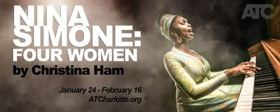Review: NINA SIMONE: Four Women at Actor's Theatre of Charlotte
NINA SIMONE: FOUR WOMEN
AT ACTOR'S THEATRE OF CHARLOTTE

February is designated as Black History Month. What a befitting opportunity for Actor's Theatre of Charlotte to pay tribute to a multi-talented singer/pianist/activist, who incidentally was a native of Tryon, North Carolina, in Christina Ham's "NINA SIMONE: Four Women", derived from the self-titled song. I must give Christina super kudos for bringing this song to life. She does an excellent job with the characterization of these four women. In the opening scene, Nina Simone (Destiny Stone) elegantly-dressed in a gold silk pantsuit (which to me symbolized a person with a certain air of prestige) stood singing Mississippi Goddamn. In mid-sentence, her song was violently interrupted by the depiction of a true-to-life chronicle of African American history - the tragic 1963 bombing of 16th Street Baptist church, in Birmingham, Alabama. Four African-American girls prematurely lost their lives as the result of racial disparity and unrest in this country. Many African-American singers, such as James Brown, Aretha Franklin, Gladys Knight and of course this powerful woman with the booming voice, Nina Simone, utilized their musical gifts as a platform to speak out on civil rights issues that violently attacked and dehumanized our communities. Living in that era, I witnessed the attacks by dogs and the unleashing of venom with fire hoses on African American men, women, and children. In the play, four African American women, from different backgrounds, shared their own personal testimonies, representing the diversification of struggles.
Each of the ladies separately entered the embattled church. Aunt Sarah (Erica Ja-Ki Truesdale), the hard-working domestic (maid) who held down two jobs, entered wearing a uniform and knee-hi twisted hosiery. Her appearance and views were in stark contrast of what Nina represented, yet the injustice and cause of the struggle was the same. Throughout our history, we have witnessed and even have some "Aunt Sarahs" in our families. Aunt Sarah's hands and knees were rough and worn from scrubbing floors. She had to struggle to feed her children "by any means necessary"; yet, her faith in God was strong and her religious declaration implied that He always made a way...somehow. Every community needs an "Aunt Sarah" as a stabilizer.
The second woman, Sephronia (Krystal Gardner) represented the "skin-tone-rift" that has existed in the African American community since slavery - "light-skinned vs. dark skinned". In slavery days, darker skin women were viewed as less intelligent and only suited for field work like oxen. Whereas, lighter skin women were reserved for the "Big House" to be utilized as maids, cooks, nannies, and caregivers for the white women. From that viewpoint, it would appear that lighter skin women had a vantage point. However, both shades were violently raped and neither had choices or free will. Sephronia represented the "light-skinned" women in this play. Even though she had some European features, such as her straighter grade of hair and her lighter complexion, she was still imprisoned by the injustices of her racial identity (an ounce of Blackness, labeled you as an African American), even though it was obvious that she was of mixed heritage. Sometimes privileges have penalties that can be more burdensome than the rewards. And the conflict within her own perceptions and the biases in her own race are obvious - the struggle for identity is real.
The final woman to enter had a very peculiar name that might have been indicative of her profession...she is referred to as "Sweet Thing (Arlethia Friday)". Struggling between her profession and her personal identity...she is trapped within a society that doesn't value her enough to call her by her real name. She enters the church (wielding a switchblade) with a "chip on her shoulder" against Sephronia because she is dating "Sweet Thing's" baby daddy (Once again, the advantage of skin color!). Often misjudged because of a choice of profession, many overlook that "ladies of the night" have personal lives as well...a struggle may ensue trying to balancing the two. The switchblade symbolizes that she felt the need to be on the defense at all times, for protection of her identity.
MY take away from the play is that struggle has a way of uniting people in a peculiar way. In the midst of it you can put your differences aside and see the similarities that exist - the strength of four women to survive in a world filled with unpredictable and unavoidable tragedies. Nina Simone is truly an amazing asset to the African American history and her music strengthened us and raised awareness to the struggle we endured in an era where racial tension was heightened. Her message is still relevant and applicable to our current civil imbalances.
"NINA SIMONE: Four Women" runs through February 16, 2019, at Actor's Theatre of Charlotte (ATC). ATC is the resident theatre of Queens University of Charlotte, located in Hadley Theatre, at 2132 Radcliffe Rd., Charlotte, NC. For more information, visit www.atcharlotte.org
Reader Reviews

Videos

